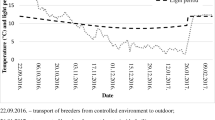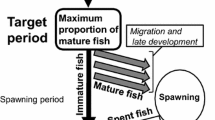Abstract
Final oocyte maturation and ovulation of captive chub mackerel Scomber japonicus with fully yolk-accumulated occytes were induced by a single injection of human chorionic gonadotropin. Reproductive parameters, including spawning frequency and batch fecundity, which are required to estimate spawning biomass in pelagic fish by the daily egg production method, were analyzed. Germinal vesicle migration (GVM) occurred at 18–24 h post-injection, and the hydration and ovulation of oocytes were completed at 30 and 36 h post-injection, respectively. The results of the maturation process suggest that fish with GVM-stage ovaries captured in the daytime from the field are capable of spawning on the night following their capture. The oocytes used in the oocyte sizefrequency distribution method for batch fecundity estimates should be at late GVM and more advanced stages. The results of sequential artificial insemination showed that the quality of ovulated eggs held in the ovarian lumen rapidly deteriorated as time progressed after ovulation. This indicates that the fertilization window for the ovulated eggs of chub mackerel lasts only a few hours, and spawning behavior should be performed within a few hours after ovulation in the wild population.
Similar content being viewed by others
References
Swanson P. Salmongonadotropin: reconciling old and new ideas. In: Scott AP, Sumpter JP, Kime DE, Rolfe MS (eds). Proceedings of the Fourth International Symposium on Reproductive Physiology of Fish. Fish Symp 91, Sheffield. 1991: 2–7.
Specker JL Sullivan CV. Vitellogenesis in fishes: status and perspectives. In: Davey KG, Peter RE, Tobe SS (eds). Perspectives in Comparative Endocrinology. National Research Council of Canada. Ottawa. 1994; 304–315.
Tyler CR, Sumpter JP. Oocyte growth and development in teleosts. Rev. Fish Biol. Fish. 1996; 6: 287–318.
Nagahama Y. 17α, 20β-Dihydroxy-4-pregnen-3-one, a maturation-inducing hormone in fish oocytes: mechanisms of synthesis and action. Steroids 1997; 62: 190–196.
Zohar Y. Fish reproduction: its physiology and artificial manipulation. In: Shilo M, Sarig S (eds). Fish Culture in Warm Water System: Problems and Trends. CRC Press, Boca Raton. 1989; 65–119.
Mylonas CC, Woods LC, Zohar Y. Cyto-histological examination of post-vitellogenesis and final oocyte maturation in captive-reared striped bass. J. Fish Biol. 1997; 50: 34–49.
Hunter JR, Lo NCH, Leong RJH. Batch fecundity in multiple spawning fishes. In: Lasker R (ed). An Egg Production Method for Estimating Spawning Biomass of Pelegic Fish: Application to the Northern Anchovy, Engraulis Mordax. NOAA Tech. Rep. NMFS-36. National Marine Fisheries Service Scientific Publications Office. Seattle. 1985; 67–77.
Greely MS, Calder DR, Wallace RA. Changes in teleost yolk proteins during oocyte maturation: correlation of yolk proteolysis with oocyte hydration. Comp. Biochem. Physiol. 1986; 84B: 1–9.
Matsubara T, Adachi S, Ijiri S, Yamauchi K. Changes of lipovitellin during in vitro oocyte maturation in Japanese flounder Paralichthys olivaceus. Fish. Sci. 1995; 61: 478–481.
Zohar Y, Mylonas CC. Endocrine manipulations of spawning in cultured fish: from hormones to genes. Aquaculture 2001; 197: 99–136.
Ohta H, Tanaka H. Relationship between serum levels of human chorionic gonadotropin (hCG) and 11-ketotestosterne after asingle injection of hCG and induced maturity in the male Japanese eel, Anguilla japonica. Aquaculture 1997; 153: 123–134.
Chuda H, Imayoshi T, Arakawa T, Matsuyama M. Hormonal treatment for induction of oocyte maturation and ovulation in cultured yellowtail, Seriola quinqueradiata. Sci. Bull. Fac. Agr. Kyushu Univ. 2001; 55: 169–177.
Chuda H, Nakao T, Arakawa T, Matsuyama M. Relationship between post- ovulation time and fertilization rate of eggs in artificial insemination of yellowtail, Seriola quinqueradiata. Nippon Suisan Gakkaishi 2001; 67: 874–880.
Patino R, Yoshizaki G, Thomas P, Kagawa H. Gonadotropic control of ovarian follicle maturation: the two-stage concept and its mechanism. Comp. Biochem. Physiol. 2001; 129B: 427–439.
Patino R, Thomas P. Effects of gonadotropin on ovarian intrafollicular processes during the development of oocyte maturational competence in teleost, the Atlantic croaker: evidence for two distinct stages of gonadotropic control of final oocyte maturation. Biol. Reprod. 1990; 43: 818–827.
Kagawa H, Tanaka H, Okuzawa K, Hirose K. Development of maturational competence of oocytes of red seabream, Pagrus major, after human chorionic gonadotropin treatment in vitro requires RNA and protein synthesis. Gen. Comp. Endocrinol. 1994; 94: 199–260.
Zhu Y, Kobayashi M, Furukawa K, Aida K. Gonadotropin develops sensitivity to maturation-inducing steroid in the oocytes of daily spawning teleost, tobinumeri- dragonet Repomucenus beniteguri and kisu Sillago japonica. Fish. Sci. 1994; 60: 541–545.
Rahman MA, Ohta K, Yoshikuni M, Nagahama Y, Chuda H, Matsuyama M. Characterization of ovarian membrane receptor for 17, 20β-dihydroxy-4-pregnen-3-one, a maturation-inducing hormone in yellowtail (Seriola quinqueradiata). Gen. Comp. Endocrinol. 2002; 127: 71–79.
Rahman MA, Ohta K, Chuda H, Nakano S, Maruyama K, Matsuyama M. Gonadotropin-induced steroidogenic shift towards maturation-inducing hormone in Japanese yellowtail during final oocyte maturaion. J. Fish Biol. 2001; 58: 462–474.
Perterson NB, Thomas P, Arnold C. Reproductive biology of the spotted seatrout, Cynoscion nebulosus, in south Texas. Fish. Bull. 1988; 86: 373–388.
Matsuyama M, Adachi S, Nagahama Y, Matsuura S. Diurnal rhythm of oocyte development and plasma steroid hormone levels in the red sea bream, Pagrus major, during the spawning season. Aquaculture 1988; 73: 357–372.
Matsuyama M, Adachi S, Nagahama Y, Maruyama K, Matsuura S. Diurnal rhythm of serum steroid hormone levels in Japanese whiting, Sillago japonica, a dailyspawning teleost. Fish Physiol. Biochem. 1990; 8: 329–338.
Matsuyama M, Ohta K, Morita S, Hoque MM, Kagawa H, Kambegawa A. Circulating levels and in vitro production of two maturation-inducing hormones in teleost: 17α, 20β-dihydroxy-4-pregnen-3-one and 17α, 20β, 21-trihydroxy-4-pregnen-3-one in a daily spawning wrasse, Pseudolabrus japonicus. Fish Physiol. Biochem. 1998; 19: 1–11.
Lasker R. Introduction: an egg production method for anchovy biomass assessment. In: Lasker R (ed): An Egg Production Method for Estimating Spawning Biomass of Pelegic Fish: Application to the Northern Anchovy. Engraulis Mordax. NOAA Tech. Rep. NMFS-36. National Marine Fisheries Service Scientific Publications Office, Seattle. 1985; 1–3.
Hunter JR, Macewicz B. Measurement of spawning frequency in multiple spawning fishes. In: Lasker R (ed). An Egg Production Method for Estimating Spawning Biomass of Pelegic Fish: Application to the Northern Anchovy, Engraulis Mordax. NOAA Tech. Rep. NMFS-36. National Marine Fisheries Service Scientific Publications Office. Seattle. 1985: 79–94.
Dickerson TL, Macewicz BJ, Hunter JR. Spawning frequency and batch fecundity of chub mackerel, Scomber japoncius, during 1985. Cal. Coop. Ocean. Fish. Invest. Rep. 1992; 33: 130–140.
Goldberg SR, Alarcon VH, Alheit J. Postovulatory follicle histology of the Pacific sardine Sardinops sagax, from Peru. Fish. Bull. 1984; 82: 443–445.
Yamada T, Aoki I, Mitani I. Spawning time, spawning frequency and fecundity of Japanese chub mackerel, Scomber japonicus in the waters around the Izu islands, Japan. Fish. Res. 1998; 38: 83–89.
Watanabe C, Hanai T, Meguro K, Ogino R, Kimura R. Spawning biomass estimates of chub mackerel Scomber japonicus of Pacific subpopulation off central Japan by a daily egg production method. Nippon Suisan Gakkaishi 1999; 65: 695–702.
Kobayashi M, Aida K, Furukawa K, Law YK, Moriwaki T, Hanyu I. Development of sensitivity to maturation-inducing steroids in the oocytes of the daily spawning teleost, the kisu Sillago japonica. Gen. Comp. Endocrinol. 1988; 72: 264–271.
Matsuyama M, Morita S, Nasu T, Kashiwagi M. Daily spawning and development of sensitivity to gonadotropin and maturation-inducing steroid in the oocytes of the bambooleaf wrasse Pseudolabrus japonicus. Environ. Biol. Fish. 1998; 52: 281–290.
Matsuyama M, Onozato S, Kashiwagi M. Endocrine control of diurnal oocyte maturation in the kyusen wrasse. Halichoeres poecilopterus. Zool. Sci. 2002; 19: 1045–1053.
Asano K, Tanaka S. Ovarian maturation and spawning of the Japanese common mackerel Scomber japonicus. Nippon Suisan Gakkaishi 1989; 55: 1715–1726.
Watson JJ, Pried IG, Witthames PR, Owari-Wadunde A. Batch fecundity of Atlantic mackerel, Scomberscombrus L. J. Fish Biol. 1992; 44: 591–598.
Macewicz BJ, Hunter JR. Spawning frequency and batch fecundity of jack mackerel. Trachurus symmetricus, off California during 1991. Cal COFI Rep. 1993; 34: 112–121.
Alheit J. Comparative spawning biology of anchovies. sardines, and sprats. Rapp. P.-V. Reun. Cons. Int. Explor. Mer. 1989; 191: 7–14.
Morimoto H. Time of maximal oocyte hydration and spawning in the Japanese sardine in Tosa Bay, southwestern Japan. Nippon Suisan Cakkaishi 1993; 59: 7–14.
Murayama T, Shiraishi M, Aoki I. Changes in ovarian development and plasma levels of sex steroid hormones in the wild females Japanese sardine (Sardinops melanostictus) during the spawning season. J. Fish. Biol. 1994; 45: 235–245.
Matsuyama M, Fukuda T, Ikeura S, Nagahama Y, Matsuura S. Spawning characteristics and steroid hormone profiles in the wild female Japanese sardine Sardinops melanostictus. Fish. Sci. 1994; 60: 703–706.
Tsuruta Y. Reproduction in the Japanese anchovy (Engraulis japonica) as related to population fluctuation. Bull. Nat. Res. Inst. Fish. Engine 1992; 13: 129–168.
Thresher RE. Reproduction in Reef Fishes. TFH Publications. Neptune City. 1984.
Johannes RE. Reproductive strategies of coastal marine fishes in the tropics. Environ. Biol. Fish. 1978; 3: 65–84.
Robertson DR. The role of adult biology in the timing of spawning of tropical reef fishes. In: Sale PF (ed). The Ecology of Fishes on Coral Reefs. Academic Press, San Diego. 1991; 356–386.
Hirose K, Machida Y, Donaldson EM. Induced ovulation of Japanese flounder (Limanda yokohamae) with HCG and salmon gonadotropin, with special references to changes in the quality of eggs retained in the ovarian cavity after ovulation. Nippon Suisan Gakkaishi 1979; 45: 31–36.
Norberg B, Valkner V, Huse L, Karlsen I, Grund GL. Ovulatory rhythm and egg viability in the Atlantic halibut (Hippoglossus hippoglossus). Aquaculture 1991; 97: 365–371.
Koya Y, Matsubara T, Nakagawa T. Efficient artificial fertilization method based on the ovulation cycle in barfin flounder Verasper moseri. Fish. Sci. 1994; 60: 537–540.
Chuda H, Matsuyama M, Hara Y, Yada T, Matsuura S. Relationship between post-ovulation time and fertilization rates of eggs in artificial insemination of tiger puffer, Takifugu rubripes. Nippon Suisan Gakkaishi 1988; 64: 993–998.
Author information
Authors and Affiliations
Corresponding author
Rights and permissions
About this article
Cite this article
Shiraishi, T., Ohta, K., Yamaguchi, A. et al. Reproductive parameters of the chub mackerel Scomber japonicus estimated from human chorionic gonadotropin-induced final oocyte maturation and ovulation in captivity. Fish Sci 71, 531–542 (2005). https://doi.org/10.1111/j.1444-2906.2005.00997.x
Received:
Accepted:
Issue Date:
DOI: https://doi.org/10.1111/j.1444-2906.2005.00997.x




